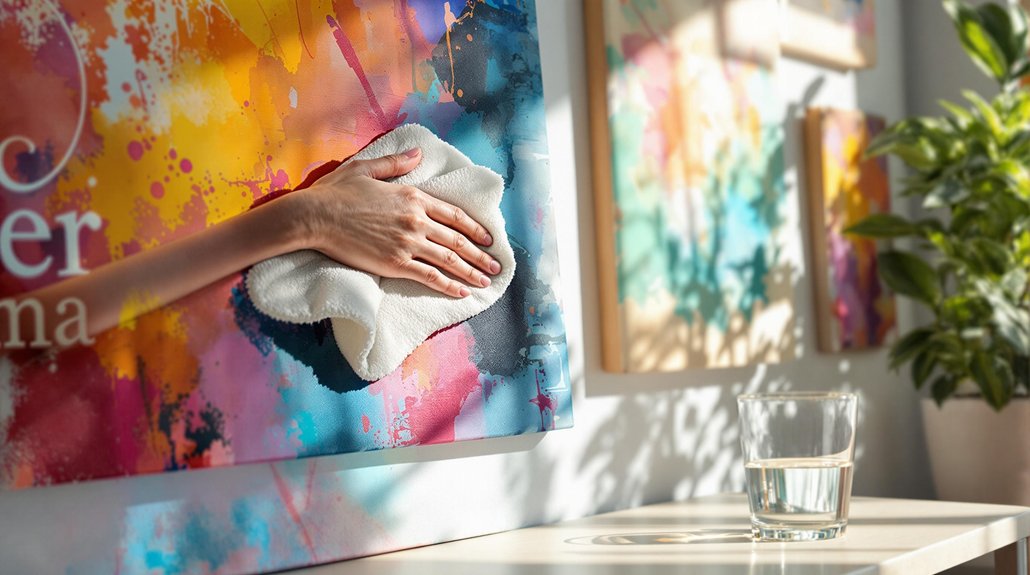Care for and maintain your wall art by dusting with a soft, natural-hair artist’s brush, and avoid dislodgment of paint. Protect your pieces from direct sunlight with curtains or UV-filtering glass because of the possibility of prolonged fading. Keep the temperature consistent at a range of 65°F to 75°F, and the humidity between 40% to 60% to avoid mold and warping. Handle artworks with clean hands or gloves and store them in acid-free materials if not displayed. In case of serious problems, professional conservators should be consulted to ensure proper restoration methods are utilized. There is so much more to explore on ideal preservation strategies.
Dusting and Cleaning Techniques
Dusting and cleaning a wall art requires great care, ensuring that nothing whatsoever gets damaged. First, take up the flat, soft, natural-hair artist’s brush-about 2-3 inches in width and 2-inches long hair.
Always examine the painting in strong light before dusting for raised fragments or loose areas; if powdery paint is found, do not dust at all. When it is time to dust, in short strokes-down first and then across-exert the least amount of pressure on the surface. Cloths should not be used because they have a possibility of snagging or dislodging paint. Regular dusting helps preserve the vibrancy and longevity of artworks.
If light cleaning is not enough, it is necessary to use either dry cleaning materials or aqueous methods on well-bound paint films only. A vacuum cleaner may also be useful in dust removal and should be applied with caution using a long hose attachment. Stains can be carefully pat dried using a damp cloth and then dried with a clean towel to avoid excess moisture.
If so, this might need soapy water-ensure that you wring out the cloth to avoid over-saturation; clean in soft circular motions. Let it dry completely out of the direct sunlight.
Check your artwork every 4 to 6 months and dust lightly when required by applying safe dusting techniques without any harsh cleaning materials to ensure that your art retains its significance.
Protecting From Sunlight Damage

While dusting and cleaning are crucial for the maintenance of wall art prints, protecting them from sunlight damage is equally important. Direct sunlight causes extreme fading and deterioration; hence, you should avoid hanging your art near windows and choose locations that receive less sunlight.
Consider using curtains or shades during peak sunlight hours to effectively filter the light. For best results, avoid south-facing windows, as they expose artwork to intense sunlight.
Using protective materials extends the life of your art. Consider choosing UV-filtering glass or acrylic in framing to help block out harmful UV rays. The quality of the framing material can make a large difference in how well your art is preserved. Besides blocking harmful UV rays, high-quality conservation glass also provides a buffer against humidity and dust.
If your artwork lacks glass, apply UV-resistant coatings or varnishes for added protection. Museum glass offers maximum UV filtration, an excellent choice for valuable pieces.
Be mindful of the type of artwork you own. Watercolors and textiles require extra care, while oil and acrylic paintings should avoid prolonged sun exposure.
Moreover, regular rotation of your artwork spreads sunlight exposure, which helps further in preserving your pieces. These tips help you maintain the beauty and integrity of your wall art for many years to come.
Humidity and Temperature Management
Humidity and temperature are crucial factors to manage as they help you safeguard your wall art’s durability. Ideally, a temperature between 65°F to 70°F (18°C to 21°C) in winter and 70°F to 75°F (21°C to 24°C) in summer. The humidity levels should remain between 40% to 60% RH to avoid damage and ensure stability. Large, noticeable changes in temperature and humidity cause expansion, contraction, and chemical reactions in your artworks. Employ passive humidity control: programmable hygrometers and thermometers monitor your environment. Portable dehumidifiers, humidifiers, and air conditioners can provide temperature stability in small areas.
Ensure good air circulation around your works of art to prevent the establishment of microclimates that might be detrimental to them. Proper framing protects and enhances artworks, so be sensitive to the specific material sensitivities within your collection; each may have unique requirements for humidity and temperature. Stable environments are crucial for maintaining the integrity of artworks, so always aim for consistent environmental conditions across seasons.
Proper Handling and Storage

Care of wall art involves great attention to handling and storage. First, one should make sure that hands are clean and dry; it is advisable to use cotton or nitrile gloves to avoid oil transfer. Clean hands are acceptable in some instances, but generally, gloves are preferred for sensitive objects. Avoid wearing bulky clothes or jewelry that might dangle and scratch the artwork.
Move the pieces carefully, looking at each one individually, and try to handle them one at a time with both hands for stability and control. Taking good care of the tools means durability and performance, which is critical in handling sensitive wall art.
Store in a clean, dry space. Keep supplies in clear, labeled containers, and protect pieces further with tissue paper, which is acid-free. Avoid stacking canvases; it will scratch them.
When it comes to the display of the art, let it have room to breathe and avoid direct sunlight as this might cause fading. Make sure stored pieces are ventilated on a regular basis and kept away from sources of heat, such as radiators.
Finally, have your stored artwork periodically checked for wear or damage. Do not do anything with specific handling and storage about which you are uncertain; instead seek professional help.
The set of procedures above will not only make your wall arts last longer but also retain integrity.
Restoration and Professional Care
Restoration and professional care can help in retaining wall art integrity for a long time and for aesthetic purposes. Professional services need to be hired for a full analysis and documentation of the condition of your artwork. The detailed study here involves techniques such as UV light and X-ray analyses, which may show hidden damages and earlier restorations. Heavy documentation done through photography and reports ensures that the restorations are reversible.
Cleaning is done by professionals who use light and selective methods according to the type of materials that make up your work. This would involve soft brushes and special cleaning agents, taking care that the support does not become too moist if porous. Testing cleaning solutions is quite essential in order not to damage the original paint. Moreover, different restoration techniques are very important in maintaining the integrity of an artwork while cleaning. Moreover, working with conservators ensures that the best practices are followed during the course of restoration efforts.
In terms of repair and inpainting, restoration techniques place a focus on stabilizing flaking paint and repairing tears in the canvas. Professionals consolidate artwork and fill gaps with reversible materials, making restoration possible in the future.
Protective measures, such as varnishing, protect your art from environmental factors and make the colors richer. By investing in professional restoration services, you go a long way in ensuring that your wall art retains its value and beauty.
General Maintenance Tips
Wall art integrity requires an ongoing commitment and care beyond professional restorations. Regular dusting is paramount for preserving art: take a soft, lint-free cloth or a feather duster to deter dust accumulation that dulls colors and surfaces. Regular maintenance also extends the life of your artwork. Knowing exactly how different types of art must be taken care of can appreciate them and offer their longevity accordingly.
Avoid water and cleaning products on the canvas, as they may destroy the paint and fabric. Handle artwork by the sides or back of the frame without touching the front surface.
Display your works away from direct sunlight and moisture for optimum display aesthetics. Such environmental elements may cause the works to fade, warp, or even develop mold. Keep the temperature stable at about 21-24 degrees Celsius for an extended life of the artworks.
Excessively high humidity is equally destructive, while too low can be brittle. Handling artwork: The object should always be handled with both hands and wrapped in acid-free paper or bubble wrap.
Frame properly: UV-protective glass can be used on prints but never on oil paintings, as it will surely cause condensation to develop and damage the painting. Store each separately in a well-ventilated area and check regularly for dampness to ensure long-lasting art preservation.
Conclusion
Caring for your wall art is like nurturing a vulnerable plant; both need care and a suitable environment to flourish. Following appropriate dusting, protection from sun exposure, and maintaining the required level of humidity will help in their long life. Remember to always be careful with your art and to let a professional restore it when it is time. By doing so, you keep your wall art fresh, making it a focal point in your space for years to come and reflecting your unique style and passion.

